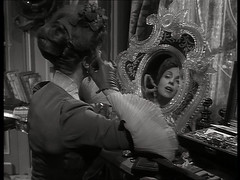261. Pickup On South Street (1988)

Directed By Samuel Fuller
Synopsis
A woman gets her wallet stolen on the subway. What she didn't know was that she had a sensitive bit of microfilm that she was supposed to give to the commies. The Government is also after the microfilm, and the pickpocket sees himself caught between these two powerful forces. He is trying to sell the microfilm to the girl who he stole it from, but when she discovers that she has been working for commies she won't let him sell it to them. She steals the microfilm and gives it to the police, who then tell her to give it to the commies so they can see where it is going. She does, not knowing that the pickpocket has kept a frame for himself. When her contact finds this missing he shoots her and takes the film. The pickpocket is waiting for the Reds to come and get the remaining frame, and when they do he follows the woman's contact to the drop-off, after a violent fight he gets the whole film back and gives it to the police. The fully recovered woman and him go off into the figurative sunset.
Review
Rarely are propaganda films any good, and those made under the Red Paranoia of the fifties in the States are not any better. But this one does have something to it. Firstly it is directed by a great director, the cast is consistently good and there is an inordinate amount of violence, which probably passed the censors because the message was one that they approved of.
Still the film is not overly ideological, and that is what saves it, the characters have their own motivations to do what they are doing, and only rarely is that patriotism. Of course the whole thing is tainted with paranoia, but it doesn't ring impossible, particularly as we have seen even in these post-soviet days some of the tactics of the Russian regime, at least there is no Polonium-210 in this film.
So it stands up quite well, even if it is clearly propagandy, but it has some very well directed moments, particularly the moments of quite painful violence, it is the first time on this list that I have seen a guy hit his face on each of the subway steps while someone is pulling his legs.
Final Grade
8/10
Trivia
From Wikipedia:
In August 1952, the script was deemed unacceptable by the Production Code, by reasons of "excessive brutality and sadistic beatings, of both men and women." The committee also expressed disdain for the vicious beating of the character "Candy", on the part of "Joey." Although a revised script was accepted soon after, the studio was forced to shoot multiple takes of a particular scene in which the manner of Jean Peters and Richard Kiley frisk each other for loot, was too risqué.
The French release of the movie removed any reference to spies and microfilm in the translation. They called the movie Le Port de la Drogue (Port of Drugs). The managers of 20th Century Fox thought that the theme of communist spies was too controversial in a country where the Communist Party was still hugely influential.
Go to 1 minute 13 for particular violence:












